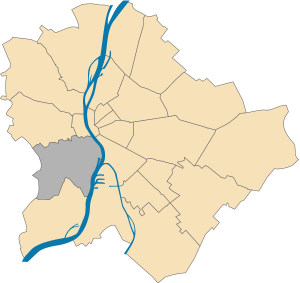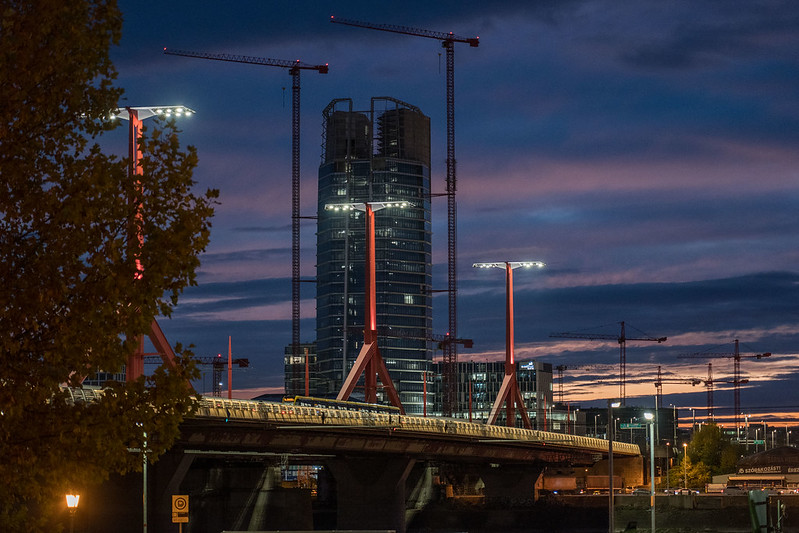Discover Újbuda: The Heart of Budapest’s Vibrant South
Újbuda, also known as Budapest’s XI. district is a captivating blend of history, culture, and natural beauty. As the most populous district of the Hungarian capital, it offers a unique blend of modernity and tradition, making it a must-visit for any traveler.
Introduction
Újbuda, translating to “New Buda,” is a testament to Budapest’s ever-evolving nature. Situated in the southern part of Buda, it’s a district that has witnessed significant transformations over the centuries, from its ancient roots to its current status as a bustling urban hub.
Location

Nestled on the banks of the iconic Danube River, Újbuda is bordered by the V., IX., XXI., and XXII. districts of Budapest. Its strategic location has made it a significant transportation and cultural hub, connecting various parts of the city through its four Danube bridges.
Geography
The district boasts a diverse topography, with the majestic Gellért Hill being one of its most notable features. This hill, reaching a height of 235 meters above sea level, offers panoramic views of the city and the Danube. Other significant geographical features include the Sas-hegy and the Rupp-hegy, both of which are part of the Budai-hegység mountain range.
Landmarks
Újbuda is home to the Citadel, a fortress atop the Gellért Hill. This historic structure was built in the 19th century and has since become a district symbol. The district also houses the renowned Gellért Thermal Bath, a testament to the region’s rich thermal water resources.

Gellért Hill (Gellérthegy)
Steeped in history, the majority of the architecture in this district hails from the 20th century. However, standing proudly from the 19th century is the Citadel, perched at the hill’s summit. This monumental fortress now hosts a range of entertainment venues and captivating exhibitions.
Just a stone’s throw away, you’ll discover one of Budapest’s iconic landmarks – the Statue of Liberty, masterfully crafted by Zsigmond Kisfaludi Strobl in 1947. From the vantage point of Gellért Hill, visitors are treated to a breathtaking panorama, encompassing the vibrant cityscape of Pest and the historical charm of the Buda Castle district.
On the southeastern slopes of Gellért Hill, the Chapel of the Rock emerges, designed by the artistic duo Kálmán Lux and Károly Weichinger in 1931. Accompanying the chapel is the neo-Romanesque monastery, established in 1934 along the Gellért embankment for the esteemed Palatine Order. The chapel’s entrance is graced by a statue of St. Stephen, sculpted by Pál Kő in 2001, with a commanding stone cross overseeing the landscape from above.
To the south, architectural wonders continue with the Eötvös College, a masterpiece by Ignác Alpár from 1910, flanked by the Lazarist monastery and school. Not to be missed is the striking edifice of the former College of Public Administration, a modernist gem from the mind of Sándor Törőcsik in 1979.
All of Gellért Hill, encompassing the regal structures on St. Gellért Square, proudly stands as a recognized World Heritage Site of Budapest. Explore and immerse yourself in its rich tapestry of history and culture.
Szentimreváros: A Historical Tour
Nestled at the base of Gellért Hill and near the illustrious Liberty Bridge, which dates back to 1896, stands an architectural marvel – the Gellért Hotel and Spa. Completed in 1918, this Art Nouveau masterpiece was brought to life by the combined visions of Artúr Sebestyén, Izidor Sterk, and Ármin Hegedűs. The Fountain House, built in 2003, is a testament to Budapest’s renowned spa culture.
Wandering through the streets of Szentimreváros from Gellért Square to Móricz Zsigmond Boulevard and Kosztolányi Dezső Square, one can marvel at the houses predominantly from the early 20th century. At the heart of the district lies the Gárdonyi Square, rejuvenated in 2010. Here, you’ll discover a statue of János Horvay from 1932, graciously erected through public contributions. As you traverse the Móricz Zsigmond Boulevard, look out for the iconic statue of St Imre by Zsigmond Strobl Kisfaludi from 1930 and the uniquely designed Gomba service building by József Schall from 1942, thoughtfully renovated in 2014. Paying tribute to the boulevard’s namesake is a statue of Zsigmond Móricz, crafted by Imre Varga in 2004.
Venturing onto Villányi út, the neo-Baroque structures command attention: St. Margaret’s Grammar School by Gáspár Fábián (1930), the St. Imre Church, and St. Imre Grammar School, both envisioned by Gyula Wälder in 1938 and 1929 respectively. Between these architectural marvels stands the statue of Kunó Klebelsberg by Jenő Grantner from 1939, commemorating the esteemed educational reformer of the Horthy era. Reinstalled in 2001, it reminds us of his lasting influence.
Across the street, near the serene Feneketlen Lake, one finds the New Buda Park Stage. This revived outdoor gathering space reopened in 2015 after a decade’s hiatus, designed by Ferenc Pálfy, Antal Studer, and István Vitkovits in 1958. The park houses the statues of Dezső Kosztolányi by Tibor Borbás (1979) and Béla Bartók by József Somogyi (1981). While Kosztolányi’s statue proudly oversees the square dedicated to the writer, Bartók’s statue stands tall on the street named in his honor. Finally, a poignant bronze statue of a girl located at Feneketlen Lake’s southwest corner is a tribute to the collaborative efforts that birthed this beautiful park.
Experience the blend of history, culture, and architecture that Szentimreváros proudly offers.
Lágymányos: A Blend of Tradition and Modernity
Lágymányos, a district rich in history and innovation, is home to the magnificent Műegyetem. From the turn of the century, this architectural wonder was masterfully crafted by Győző Czigler, Alajos Hauszmann, and Samu Pecz. Not far from it, the modern campus of ELTE stands as a beacon of contemporary education. Bordering these esteemed institutions is the Church of the Hungarian Saints, a divine creation by Ferenc Török and Mihály Balázs, dating back to 1996.
As you wander through the district, you’ll encounter the statue of the celebrated Frigyes Karinthy, sculpted by Iván Paulikovics in 1988. It proudly stands at the junction of the streets bearing his name and that of Irinyi József. Another highlight is the statue of József Egry, resembling the iconic bronze figure from Badacsony, albeit uniquely mounted on a bronze “steg”.
Since 2015, the stretch of Buda Lower Quay nestled between the Rákóczi and Petőfi bridges has been renamed in honor of the Polish hero, Henryk Sławik, commemorating it as the Henryk Sławik Quay.
Incorporating a touch of modern flair to the district is the Fehérvári út Market Hall. Originally designed by György Halmos in 1975, this space was rejuvenated by Tibor András Kertész in 2003. Adjacent to it lies the bustling Allee shopping center and the neighboring Simplon Udvar residential complex, added in 2009.
Venturing deeper into Lágymányos, architectural enthusiasts can admire the towering edifice of the former Váli Street School, built in 1912, followed by a clinic designed by Jenő Szendrői and Andor Lévai in 1949. Completing this historical journey is the Reformed Church of Kelenföld, envisioned by István Medgyaszay. Officially named the Hungarian Advent Church, this religious landmark was established in 1929.
Experience Lágymányos, where the old meets the new, and history intertwines seamlessly with the present.
Kelenföld: A Mosaic of Heritage and Innovation
In the northern reaches of Kelenföld, the neo-Romanesque Kelenföld Evangelical Church stands as a testament to the architectural prowess of János Schulek, constructed in 1928. This district is also home to the historic Kelenföld railway station, a design archetype from the 1870s. Along the Danube bank, one can witness the industrial remnants of yesteryears – the Buda Steam Power Station from 1911 and the Kelenföld Thermal Power Station, which started its operations in 1914 and was finalized in 1937, following the intricate designs of Kálmán Reichl and Virgil Borbiró.
On the outer stretch of Bartók Béla út, the St. Gellért Church, a creation of András Kiss, welcomes visitors with its majestic presence. It opened in 1992, and its bell tower, which graces the skyline, was completed in 1999. The artistic flair of Imre Varga adorns the church grounds, showcasing the statue of Pope Sylvester II and the mesmerizing statues of the Árpád saints within its gardens.
Near the Kelenföld railway station, one can find the contemporary Reformed Parish Church of Outer Kelenföld, designed by István Szabó in 1981. At the heart of the residential ring stands the Kelenföld City Centre, a service building conceptualized by István Zilahy and brought to life in 1966. Adjacent to this center, the park features the striking statue of István Kiss Monda from 1979, portraying a trio of majestic bulls.
Kelenföld beckons visitors with its harmonious blend of historical significance and modern evolution, making it a must-visit locale in any journey through time and art.
The Outlying Districts: A Tapestry of Hidden Gems
While the outlying districts may not boast the grandeur of central Budapest, they certainly are rich in history and unique charm.
Albertfalva holds remnants of its Roman past, with just a few ruins from the Roman camp still visible to the discerning eye. St. Michael’s Roman Catholic Church, a beautiful edifice designed by Jenő Kismarty Lechner and his son, Jenő Lechner Jr., was inaugurated in 1941. Notably, it was Jenő Lechner who previously designed the revered Kismarty Church in the 19th century.
Kelenföld’s Holy Trinity Church, completed in 1931, stands as a testament to the architectural ingenuity of Károly Weichinger. Unfortunately, the medieval remnants of Kőérberek remain hidden from public view. In contrast, the neighborhood of the Gazdagrét housing estate boasts the Church of the Holy Angels, a modern structure envisioned by István Koppányi and opened to the public in 2002.
Sasad offers glimpses into its 18th-century history with two Baroque statues. St. Francis Xavier graces the American Cemetery on its southeastern edge, while a statue of the Holy Trinity stands proudly on its northern perimeter along Törökbálint Road.
Lastly, in Őrmező, the Poets’ Park is a homage to the literary world. It features a relief dedicated to László Kálnoky, István Kormos, and Zoltán Zelk – the latter having spent his twilight years within the estate.
The outlying districts invite exploration, promising pockets of history, art, and culture awaiting discovery by those with a penchant for the lesser-known tales of Budapest.
History
The history of Újbuda is a tapestry of various cultures and epochs. From the Bronze Age settlements discovered in the region to its occupation by the Eravisci Celtic tribe in the 4th century BC, Újbuda has been a melting pot of civilizations. The Roman era established significant structures, including forts and baths. The district also played a pivotal role during the Ottoman occupation, with landmarks like the Aga Bath tracing back to this period.
Demographics
As of 2021, Újbuda boasts a population of approximately 144,880 residents. This diverse community reflects the district’s rich history and appeal as a modern urban center.
Education
Újbuda is a hub for education and knowledge. The district is home to the Budapest University of Technology and Economics, one of Hungary’s most prestigious institutions. Additionally, the region has several schools, colleges, and research centers, making it a focal point for academic excellence.
Twin Towns
Újbuda has fostered international relations through its twin towns, including Marosvásárhely (Romania), Ada (Serbia), Trogir (Croatia), and several others. These partnerships highlight the district’s commitment to global collaboration and cultural exchange.
Google Maps of Újbuda (District 11)
Conclusion
Újbuda is more than just a district; it’s a journey through time. From its ancient roots to its modern-day vibrancy, it offers a unique blend of experiences that cater to history buffs, nature lovers, and urban explorers alike. In Budapest, visiting Újbuda is a journey you wouldn’t want to miss.